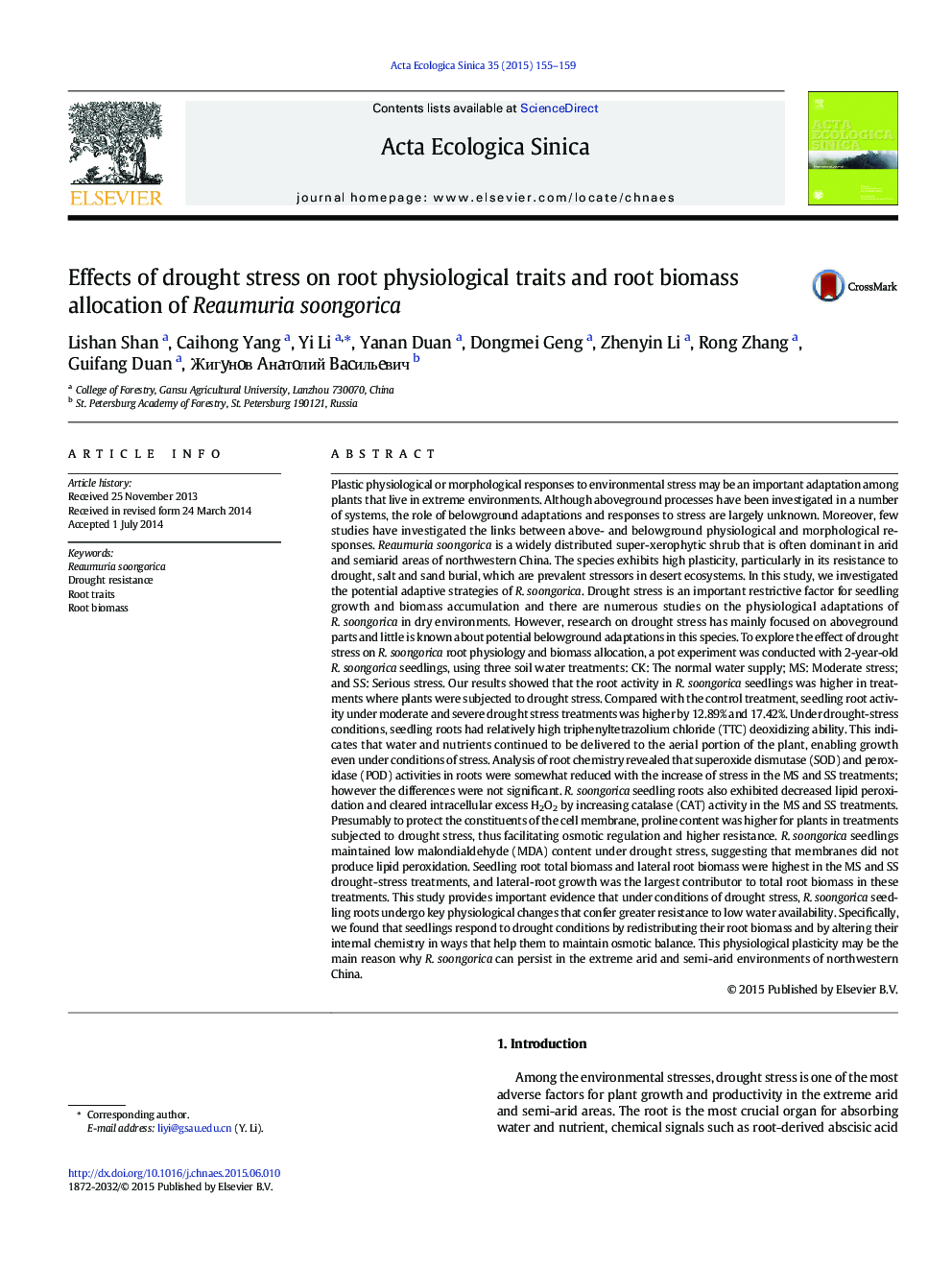| کد مقاله | کد نشریه | سال انتشار | مقاله انگلیسی | نسخه تمام متن |
|---|---|---|---|---|
| 4379773 | 1303936 | 2015 | 5 صفحه PDF | دانلود رایگان |
Plastic physiological or morphological responses to environmental stress may be an important adaptation among plants that live in extreme environments. Although aboveground processes have been investigated in a number of systems, the role of belowground adaptations and responses to stress are largely unknown. Moreover, few studies have investigated the links between above- and belowground physiological and morphological responses. Reaumuria soongorica is a widely distributed super-xerophytic shrub that is often dominant in arid and semiarid areas of northwestern China. The species exhibits high plasticity, particularly in its resistance to drought, salt and sand burial, which are prevalent stressors in desert ecosystems. In this study, we investigated the potential adaptive strategies of R. soongorica. Drought stress is an important restrictive factor for seedling growth and biomass accumulation and there are numerous studies on the physiological adaptations of R. soongorica in dry environments. However, research on drought stress has mainly focused on aboveground parts and little is known about potential belowground adaptations in this species. To explore the effect of drought stress on R. soongorica root physiology and biomass allocation, a pot experiment was conducted with 2-year-old R. soongorica seedlings, using three soil water treatments: CK: The normal water supply; MS: Moderate stress; and SS: Serious stress. Our results showed that the root activity in R. soongorica seedlings was higher in treatments where plants were subjected to drought stress. Compared with the control treatment, seedling root activity under moderate and severe drought stress treatments was higher by 12.89% and 17.42%. Under drought-stress conditions, seedling roots had relatively high triphenyltetrazolium chloride (TTC) deoxidizing ability. This indicates that water and nutrients continued to be delivered to the aerial portion of the plant, enabling growth even under conditions of stress. Analysis of root chemistry revealed that superoxide dismutase (SOD) and peroxidase (POD) activities in roots were somewhat reduced with the increase of stress in the MS and SS treatments; however the differences were not significant. R. soongorica seedling roots also exhibited decreased lipid peroxidation and cleared intracellular excess H2O2 by increasing catalase (CAT) activity in the MS and SS treatments. Presumably to protect the constituents of the cell membrane, proline content was higher for plants in treatments subjected to drought stress, thus facilitating osmotic regulation and higher resistance. R. soongorica seedlings maintained low malondialdehyde (MDA) content under drought stress, suggesting that membranes did not produce lipid peroxidation. Seedling root total biomass and lateral root biomass were highest in the MS and SS drought-stress treatments, and lateral-root growth was the largest contributor to total root biomass in these treatments. This study provides important evidence that under conditions of drought stress, R. soongorica seedling roots undergo key physiological changes that confer greater resistance to low water availability. Specifically, we found that seedlings respond to drought conditions by redistributing their root biomass and by altering their internal chemistry in ways that help them to maintain osmotic balance. This physiological plasticity may be the main reason why R. soongorica can persist in the extreme arid and semi-arid environments of northwestern China.
Journal: Acta Ecologica Sinica - Volume 35, Issue 5, October 2015, Pages 155–159
